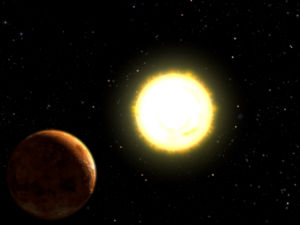55 Cancri e
2008/9 Schools Wikipedia Selection. Related subjects: Space (Astronomy)
| Extrasolar planet | List of extrasolar planets | |
|---|---|---|
 |
||
| Parent star | ||
| Star | 55 Cancri A | |
| Constellation ( pronunciation) |
Cancer | |
| Right ascension | (α) | 08h 52m 35.8s |
| Declination | (δ) | +28° 19′ 51″ |
| Distance | 40.9 ly (12.5 pc) | |
| Spectral type | G8V | |
| Orbital elements | ||
| Semimajor axis | (a) | 0.038 ± 0.001 AU |
| Eccentricity | (e) | 0.174 ± 0.127 |
| Orbital period | (P) | 2.81 ± 0.002 d |
| Angular distance | (θ) | 3 mas |
| Longitude of periastron |
(ω) | 261.65 ± 41° |
| Time of periastron | (T0) | 2,453,295.31 ± 0.32 JD |
| Semi- amplitude | (K) | 5.80 ± 0.81 m/s |
| Physical characteristics | ||
| Mass | (m) | >0.045 ± 0.01 MJ (>14 ± 3 M⊕) |
| Discovery information | ||
| Discovery date | August 31, 2004 | |
| Discoverer(s) | McArthur et al. | |
| Detection method | Radial velocity | |
| Discovery site | Texas, USA | |
| Discovery status | Published | |
| Other designations | ||
|
Rho1 Cancri e, HD 75732 e
|
||
55 Cancri e is an extrasolar planet with a mass similar to that of Neptune orbiting the Sun-like star 55 Cancri A. It takes less than three days to complete an orbit and is the innermost known planet in its planetary system. 55 Cancri e was discovered on August 30, 2004.
Discovery
Like the majority of known extrasolar planets, 55 Cancri e was discovered by detecting variations in its star's radial velocity. This was achieved by making sensitive measurements of the Doppler shift of the spectrum of 55 Cancri A. At the time of its discovery, three other planets were known orbiting the star. After accounting for these planets, a signal at around 2.8 days remained, which could be explained by a planet of at least 14.2 Earth masses in a very close orbit. The same measurements were used to confirm the existence of the uncertain planet 55 Cancri c.
55 Cancri e was one of the first extrasolar planets with a mass comparable to that of Neptune to be discovered. It was announced at the same time as another "hot Neptune" orbiting the red dwarf star Gliese 436 named Gliese 436 b.
Planet challenged
In 2005 the existence of planet e was questioned by Jack Wisdom in a reanalysis of the data. According to him, instead of the 2.8-day planet there is a planet with a mass similar to that of Neptune in a 261-day orbit around 55 Cancri A. In 2007, Debra Fisher and colleagues at San Francisco State University published a new analysis indicating that both planets existed; the planet in the 260-day orbit was accordingly designated 55 Cancri f.
Orbit and mass
55 Cancri e is located in a very close orbit around the star which takes less than three days to complete and falls into the category of "hot Neptunes". The planet's orbit is fairly eccentric, a result of interactions with the nearby Jupiter-mass planet 55 Cancri b which prevent tidal forces from circularising the orbit.
A limitation of the radial velocity method used to detect 55 Cancri e is that only a minimum mass can be obtained, in this case around 14.2 times that of Earth, or 80% of the mass of Neptune. Astrometric observations made with the Hubble Space Telescope suggest that the outer planet 55 Cancri d is inclined at 53° with respect to the plane of the sky. If these measurements are confirmed and the system is assumed to be coplanar, the true mass of the planet would therefore be about 25% greater than this lower limit, at around 1 Neptune mass.
Characteristics
Since the planet has only been detected indirectly through its gravitational influence on 55 Cancri A, properties such as its radius, composition and temperature are unknown. It is also unknown whether it is a small gas giant like Neptune or a large terrestrial planet. Large terrestrial planets may be formed from material compacted by the inward migration of the system's gas giants. Alternatively 55 Cancri e may be the core of a gas giant pushed inwards before it had time to accumulate a significant gaseous envelope.
It is considered unlikely that the planet is the evaporated remnant of a gas giant (a chthonian planet). The existence of transiting Jovian planets in short period orbits indicates that gas giants can survive for long timescales in the inner regions of a planetary system.